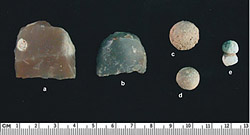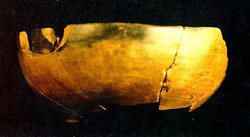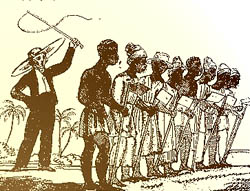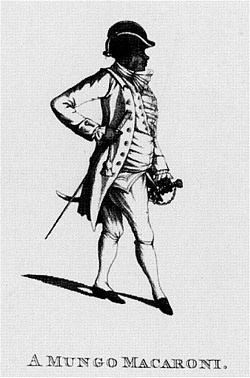Material Culture: Subsistence & Foodways
It is difficult to uncover reliable information about the foodways of enslaved people from secondary accounts written by European eyewitnesses. Bolzius, for example wrote to prospective immigrants in Germany trying to convince them to settle in Georgia and South Carolina. His 1750 account of the enslaved people’s foodways emphasize the positive aspects of establishing a plantation in the colonies while minimizing the costs for such a venture (Bolzius 1750, Translated and edited by Loewald, Starika and Taylor, 1957). ” Another description, written twenty-five or thirty years later, by a European traveler reported a dismal picture of poorly fed people totally dependent upon the humanity of “their master” for a scanty diet (Anbury as cited in Travelers’ Impressions 1916:407–408). Anburey, like Bolzius, attributed little self-sufficiency to enslaved people and both of their comments reflect the prevailing European beliefs and attitudes towards Africans. Aside from personal bias, eyewitness testimony of people’s foodways suffers from many other limitations such as the relatively small number of observations that any one individual may make, the differences that time, taste and circumstance may introduce to observed availability of foods, their preparation or consumption (Rietz, Gibbs and Rathbun 1985:168–170). Archeological studies of 18th century sites where enslaved people lived extends our understanding of their foodways through more objective data, albeit still based on small samples.
In 1987, Brockington and Associates unearthed the village occupied by enslaved workers on Snee Farm located on the Charles Pinckney National Historic Site, a place commemorating the life and public services of Pinckney (1757–1824), one of the drafters of the United States Constitution. As noted in the Charles Pinckney Historic Resource Study, “in many ways the landscape of the Low Country plantation belonged as much to the slaves as to the planters. On Snee Farm, evidence of the slave contribution is everywhere. Slaves cleared the land, built the roads, constructed the houses and outbuildings, and planted the crops. The slaves, as lifelong permanent residents, considered the plantation home (Blythe, Kliene, Moffson, 2000:32.)” Archeological evidence from Snee Farm offers a data-based view of enslaved Low Country peoples’ foodways:
“Scattered around the Snee Farm slave village are pits filled with refuse. The uses of these pits probably evolved over time. Pits originally would have been dug to supply clay for the daubing of structure walls. Later, the clay was used for crafting pots. Once the clay was depleted, they became roasting pits for oysters and clams. Finally, slaves filled the pits with refuse and swept in dirt. These pits further illustrate slave life on Snee Farm by providing insight into diet and foodways. The refuse in the pits is particularly instructive. The presence of fish and animal bones provides confirmation that Snee Farm slaves worked under the task system and had time to hunt and fish. The presence of squash rinds may indicate that they kept gardens. …Trash pits containing crustacean shells and animal bones point to the slaves ability to control their own foodways through fishing and hunting The fence that may have lined the domestic compound indicates slaves kept gardens and domesticated animals. A lead shot found in a posthole of one of the slave dwellings indicates slave ownership of guns for hunting (Brockington, Stine, and Huddleston 1994:16,13).”.
Some contemporary scholars argue that the diet enslaved people managed to supply themselves and their customary food preparation practices yielded a nutritious diet.
Evidence of the slave diet and foodways is also gleaned from the Colono Ware fragments found at the site. The three sizes of Colono Ware bowls are confirmation that the diet of the slaves remained relatively African.
Most West Africans traditionally ate a little meat, fish or fowl with rice or millet the typical diet consisted of a starch such as millet, corn, or rice served with a spicy vegetable sauce. The vegetables and spices included beans, squash, hickory nuts, cow peas, okra, eggplant, tamarind, onions, peanuts, sesame seeds, and peppers. The slaves probably also consumed their food in a traditionally African manner. A designated cook prepared communal meals in a large Colono Ware bowl or later in a cast iron pot. The accompanying sauces were served in medium-sized Colono Ware bowls. Individuals ate their food with their hands from small Colono Ware bowls or clean leaves. This extensive use of Colono Ware explains the massive quantities usually found at slave sites, including Snee Farm (Brockington, Steine and Huddleston 2000:33–35).
Read more about looking at Low Country enslaved people’s foodways through the lens of archeology.
Material Culture: Making “Magic Bowls”
Colono Ware ceramics made on the plantation were the most common artifacts recovered from the Yaughan and Curriboo slave quarters. Wheaton and Garrow concluded the Colono Ware was made by African Americans and was of West African derivation (1985:251). As late as 1776, after British ceramics appear, Colono Ware still made up 40.6% of the artifacts recovered from this site (Ferguson, 1992:110–115).
Colono Ware, a low-fired earthenware, has been found in African-American contexts on the East Coast of the United States, including African-American archaeological sites on Manassas National Battlefield Park. Learn more about archeological finds in excavations of a Low Country site where African Americans lived.
The photo is an example of Colono Ware from the park. These ceramics bear a striking resemblance to Afro-Cruzan ceramics found in the Virgin Islands from the time of the North American colonial period. These ceramics, in turn, are linked to ceramics made by African or African-descended potters in Nevis Antiqua, Jamaica, and St. Martin. Since it is thought to be unlikely that the Caribbean types also developed on the North American mainland independently, it appears that the forms are derived from West Africa or an amalgam of West African cultures. Wheaton and Garrow concluded the Colono Ware was made by African Americans and was of West African derivation (Wheaton and Garrow 1985:251)
Sherds of Colono Ware found in South Carolina formed open, in-curving bowls and small flared-mouth jars. A few of the vessels were decorated with incised lines or a cross in a circle on the interior bottoms that, as Ferguson explains, had religious connotations. He calls them Magic Bowls (Ferguson, 1992:110–115).
Other ceramics from slave site excavations that dated after 1776 were mostly of British origins as were other material cultural artifacts of later dates. Even so, in the latest dated samples from Yaughan and Curriboo, 40.6% of ceramics were still Colono Ware, indicating African influences in this aspect of African American material culture persisted well into the nineteenth century.
Material Culture: Clothing
Low Country Africans wore much the same kind of clothing as those in the Chesapeake and like them often made their own clothes. Although, sometimes the cloths were purchased, more frequently enslaved African women made clothes for themselves and their families from cloth purchased by the slave masters. By the mid-18th century, most people of African descent in urban Charlestown and Savannah were fully acculturated in terms of their clothing. On the plantations, for field hands it was a different story.
“I am going out of Town for a fortnight or more and am Apprehensive Cap[tain] W…son may sail before my return have given him directions for 5 pieces of Negro Cloth to be shiped [sic] on board him which I believe will be more than wanted, one piece is coarser the rest which I intend for the Children. Amey, I believe can cut them out without any difficulty, indeed most of the Country born and some of the others have always chose to have the Cloth given them and their Wives and Sisters to cut it out and make them up for them and as they are better satisfied [sic]…“Wrote John Channing to William Gibbons(June 26, 1770 William Gibbons Jr., Papers, Duke University as cited in Morgan 1998:129).
In 1745, a traveler reported that the region’s planters gave their slaves “no cloaths [sic] but a breech clout (Morgan 1998:133 ftn. 46),” A description corroborated by Bolzius, in his descriptions of differentiation between clothing worn by agricultural workers, household workers, and artisans:
“In winter the Negroes must be kept warm, but in the summer they go naked, except that the men cover their shame with a cloth rag which hangs from a strap tied around the body. The women have petticoats; the upper body is bare….
“A plantation Negro man receives a bad [sic] coat and long pants out of 5 yards of white or blue Negro cloth (that is the coarsest, thickest cloth), which costs about 7s., and a pair of shoes (cost 2s.6d.). The women are clothed with the same kind of cloth their clothing costs about 10s.)…
“When the masters drive or ride to town with negroes, they give them better clothes. The skilled Negroes in Charlestown, who are used in offices and shops or who are mistresses, are very well dressed…(Bolzius 1750: 236, 256 Translated and edited by Loewald, Starika and Taylor, 1957).”
Although the Africans clothing were most often blue, white and drab, an olive color, Morgan points out that enslaved people often tried to introduce individuality in their dress through usual combinations of clothing or colors. Some contemporary scholars interpret this behavior as an example of African influence on people’s choice of clothing and colors (White & White 1995). In the 1730s, for example, the clothes of South Carolina runaways included prominent displays of green, yellow, brown, red, and especially blue colors. Forty years later, the clothing of runaways was described more uniformly as blue in color (Morgan 1998:130). This may have been the result of prescriptive laws governing what enslaved people could wear.
The Negro Act of 1735 prescribing materials suitable for slave clothing, cited only the cheapest fabrics: “negro cloth, duffelds, coarse kearsies, osnabrigs, blue linnen (sic), checked linnen, coarse garlix or callicoes, checked cottons or scotched plaids.” The question of whether “Negroes should be allowed to wear cast-off clothes of their masters and mistresses was hotly debated by the legislature and a prohibitive measure carried (Statutes South Carolina 1734–1735 as cited in Wood 1974:145). Through these means, clothing was also used to reinforce social distinctions among enslaved Africans and between the masters and their slaves.
Such laws had little impact in some circles. Enslaved men benefited from slave owners efforts to reward compliant “Negroes” artisans or house servants with impressive attire from the owner’s cast off clothing or even new clothing. The objective was to distinguish them from other enslaved men. In the 1780s, Henry Laurens told his overseer, that “Sam, Scaramouche, or any other Negro who has behaved remarkably well” should be rewarded, and suggested that he “distinguish them in their cloathing by something better than white plains”. The overseer then saw to it that Laurens’s most faithful slaves received quantities of blue cloth and metal buttons (Chaplin 1990:309 as cited in White and White 1995). Furthermore, Africans managed to embellish their outfits with collars, cuffs, superfine cloth coats, beaver hats or gowns that were given to them or that they purchased with money earned in free time resulting from the Low Country task system of labor.
In 1744, citizens complained in letters to the newspaper that enslaved people in towns ignored the dress code law. “[I]t is apparent,” read one complaint, “that Negro Women in particular do not restrain themselves in the Clothing as the Law requires, but dress in Apparel quite gay and beyond their condition (Morgan 1998:601).” Twenty-five years later an anonymous letter to the South Carolina Gazette complained…” there is scare a new mode [of fashion] which favoured [sic] black and mulatto women are not immediately enabled to adopt.” The writer attributed this state of affairs to the “scandalous Intimacy between “Sexes of different Colours” (“The Stranger” as cited in Morgan 1998:601) Bacchus, a runaway during this period, apparently dressing above his station, was referred to in the newspaper as a “Macaroni” figure, alluding to “A Mungo Macaroni” a popular English caricature series that mocked African men who ignored prescribed dress codes for “negroes” (Morgan 1998:601; Memories of Slavery 2004).
As the 18th century drew to a close there were two Low Country African American societies, one acculturating rapidly to English life and customs, mostly urban, frequently employed as household servants or artisans and the other rural, agricultural and firmly entrenched in African life ways described as Gullah-Geechee Culture. The next section examines the contribution that overtime differing work roles made to culture change and the evolution of the two Low Country African American societies.









